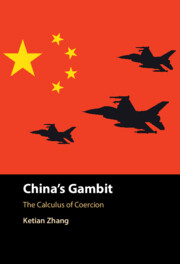Book contents
- China’s Gambit
- China’s Gambit
- Copyright page
- Dedication
- Contents
- Figures
- Acknowledgments
- Abbreviations
- 1 Introduction
- 2 The Cost-Balancing Theory
- 3 Coercion in the South China Sea
- 4 Sino-Japanese Disputes in the East China Sea
- 5 Coercion in Cross-Strait Relations
- 6 Tibet and the Dalai Lama Visits
- 7 Conclusion
- References
- Index
3 - Coercion in the South China Sea
Published online by Cambridge University Press: 30 November 2023
- China’s Gambit
- China’s Gambit
- Copyright page
- Dedication
- Contents
- Figures
- Acknowledgments
- Abbreviations
- 1 Introduction
- 2 The Cost-Balancing Theory
- 3 Coercion in the South China Sea
- 4 Sino-Japanese Disputes in the East China Sea
- 5 Coercion in Cross-Strait Relations
- 6 Tibet and the Dalai Lama Visits
- 7 Conclusion
- References
- Index
Summary
Chapter 3 examines Chinese coercion in the South China Sea. My previous work examines the overall trends of Chinese coercion in the South China Sea. I find that China used coercion in the 1990s because of the high need to establish a reputation for resolve and low economic cost. China used militarized coercion because the US withdrawal from the Subic Bay in Southeast Asia and the focus on Europe reduced China’s geopolitical backlash cost of using coercion. China then refrained from coercion from 2000 to 2006 because of the high economic cost and low need to establish a reputation for resolve. It began to use coercion again after 2007, but because of the increasing geopolitical backlash cost since the post-2000 period, Chinese coercion remains nonmilitarized, which includes economic sanctions and gray-zone coercion. This chapter also examines three case studies – the cross-national comparison of China’s coercion against the Philippines, Vietnam, and Malaysia, the Sino-Philippine Mischief Reef incident in 1995, and the Sino-Philippine Scarborough Shoal incident in 2012. These case studies demonstrate that the mechanisms of the cost-balancing theory are present in them.
- Type
- Chapter
- Information
- China's GambitThe Calculus of Coercion, pp. 46 - 96Publisher: Cambridge University PressPrint publication year: 2023



